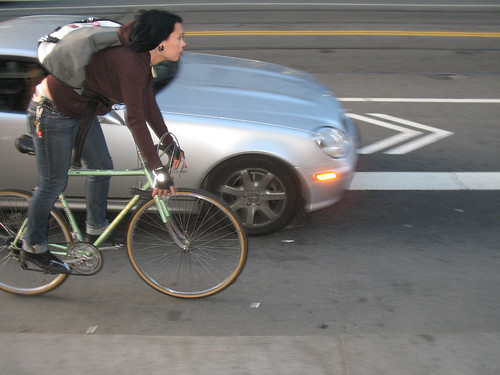
This article is re-published with permission from the California Bicycle Coalition blog.
Update: Governor Jerry Brown has vetoed the 3-foot passing bill. His statement can be found here [PDF].
The California Bicycle Coalition has compiled evidence showing that 3-foot-passing laws haven’t had any negative impacts on traffic flows in other states that have enacted these laws, and that such laws are actually boosting bicycle ridership and changing driver behavior for the better.
CBC is responding to reports that the California Highway Patrol is conjuring up worst-case scenarios as part of its whispering campaign to persuade Gov. Jerry Brown to veto Senate Bill 910, the 3-foot-passing bill cosponsored by the CBC and the City of Los Angeles.
The CHP reportedly is telling Gov. Brown that SB 910 would cause an epidemic of rear-end collisions as drivers slam on their brakes when they realize they don’t have space to pass bicyclists by at least three feet. Yet the CHP hasn’t produced any evidence of such problems in any of the 20 states that have 3-foot-passing laws on the books.
Andy Clarke, president of the League of American Bicyclists, the nation’s oldest bicycling advocacy organization, wrote this week in a letter to Gov. Brown, “In our experience working with the 19 [sic] other states that have passed three-foot passing laws, we have heard of no increases in the number of motor vehicle crashes due to the new requirements or any increased burden on law enforcement. In contrast, we have received nothing but positive responses to these laws.”
The Bicycle Federation of Wisconsin has seen no traffic problems in the 38 years since Wisconsin enacted the nation’s first 3-foot-passing law. “I’m not aware of any negative repercussions on traffic safety or capacity due to the passage of this law,” wrote Kevin Hardman, the federation’s executive director, in a letter to the CBC.
That’s also been Minnesota’s experience under the nation’s second 3-foot-passing law, enacted in the mid-1980s. “[The law] has, however, had a positive impact on bicycling,” wrote Bicycle Alliance of Minnesota Executive Director Dorian Grilley. “Over half of Minnesotans bicycle and they are bicycling more frequently. Motor vehicle drivers seem to have noticed this fact and appear to be at the beginning stages of a significant cultural shift toward respecting bicyclists and pedestrians….”
Grilley’s observation is supported by the landmark 2003 study, Safety in Numbers, which demonstrates that increases in bicycle ridership reduce the incidence of all types of bike-car collisions.
Nothing like the CHP’s nightmare occurred in Arizona after it became the nation third state to enact a 3-foot-passing law. “With respect to any assertion that this kind of law may cause some major difficulties or ‘mayhem,’ we simply have not found that to be the case in Arizona, where the law has been in effect for approximately ten years,” wrote Coalition of Arizona Bicyclists President Robert Beane.
Same in Oklahoma, according to Mike Flenniken of the Oklahoma Bicycle Coalition: “No motorists have died or been injured because of the law, not one editorial or letter to the editor has been published against the law, [and] in fact, one municipality that I know of (Edmond, Oklahoma) acted at the request of their police officers to install an ordinance to add teeth to the State law which would make it enforceable even if there were no injuries incurred.”
Nor did anyone in Nevada raise the possibility of problems when that state’s bill was being debated. According to the Nevada Department of Transportation, Nevada’s 3-foot-passing law, which took effect last Saturday, attracted no opposition at all. The Nevada Senate unanimously approved 3-foot-passing legislation in April 2011.
Originally CHP supported SB 910, a surprising sea change from five years ago, when it managed to get CBC’s earlier 3-foot-passing bill killed in its first legislative hearing.
Throughout the legislative debate over SB 910, CHP said it supported the idea of giving bicyclists at least three feet of space. And CHP actually wrote the portion of SB 910 that authorizes drivers to cross a solid double-yellow centerline – currently prohibited under CA law – to give bicyclists at least three feet when passing.
Dan Empfield, publisher of Slowtwitch, contacted the CHP’s legislative representative Capt. Avery Brown about the CHP’s opposition to the bill. Brown told Empfield the CHP prefers to see text in the bill that does not mandate a specific distance.
In effect, the CHP endorses the status quo in California, where existing state law leaves drivers to figure out what constitutes a “safe” passing distance and where more bicyclists are killed by drivers passing from behind than by any other single cause. CBC and the City of Los Angeles continue to insist that the situation is unfair to drivers and presents an unreasonable hazard for people who rely on bicycles for transportation.
Meanwhile, more than 1,500 Californians, including bicycle advocates, bicycling club officials and members, survivors and the families of victims of passing-from-behind collisions, parents, teachers, healthcare professionals and corporate leaders, have written to Gov. Brown to urge him to sign SB 910.




